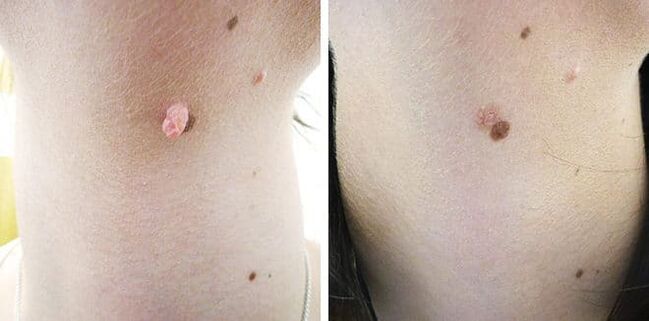Papillomas and warts are small growths on the skin of a viral nature. You must be able to distinguish them in order to promptly notice potentially dangerous formations and take the necessary measures. The main thing that distinguishes papilloma from condyloma is the type of virus-pathogen.
Causes of neoplasms
The human papillomavirus (HPV) has more than one hundred different strains. HPV enters the body through home contact or through unprotected intercourse. It is possible for the baby to become infected by the mother as she passes through the birth canal.
The formation of growths indicates the rapid division of cells in the basal layer of the skin. This occurs under the influence of a virus, the activation of which in most cases is associated with a decrease in immune defense. Depending on the strain, papillomas or warts appear on the body.
Characteristic features of papillomas
Papilloma is a benign neoplasm that does not cause discomfort, if not aesthetic. Characteristic features of papillomas:
- homogeneous soft structure;
- the presence of a leg;
- small size (up to 10 mm in diameter);
- moderate pigmentation.
Papillomas are localized on any part of the body, with the exception of the mucous membranes of the genitals. As a rule, the color of the growth varies from a natural skin tone to pinkish-red shades, however, highly pigmented papillomas are also not a pathology. The growth of hair on the body of a papilloma is a variant of the norm.

Papillomas are not dangerous if they do not interfere with the patient and are not accidentally injured in everyday life. The formation of growths of this type is due to the action of viral strains 2, 7 and 28. You can become infected with these types of HPV in everyday life and during sexual intercourse.
Characteristics of genital warts
Warts are of two types: pointed and broad growths. The first type appears with HPV infection, and large growths are one of the symptoms of syphilis.
The sites of localization of genital warts are the mucous membranes, mainly in the urogenital area, as well as the skin folds prone to rubbing against clothing.
The structure of genital warts is papillary. The formations are attached to a thin stem, the growths are fed through small vessels and capillaries. Unlike papillomas, condylomas are often inflamed, ulceration of the growth body is possible.
Genital warts are caused by 16, 18, 54 strains of the virus. These types of HPV are potentially dangerous, especially for women. There is a direct relationship between these types of viruses and the development of cervical cancer. Infection occurs through sexual intercourse.
How to distinguish papilloma from genital warts?
The external difference between the growths is easy to notice in the photo: the papillomas are homogeneous, while the condylomas have a finely papillary structure.
- The difference between papilloma and warts lies in the color of the growth. Papillomas can be highly pigmented, the color of the warts is usually clear and does not differ from the mucous membranes.
- HPV, which causes the development of papillomas, is transmitted by domestic contact, using personal hygiene products and also through a handshake (in the presence of skin microtrauma). Warts are only sexually transmitted.
- Warts become inflamed. Papillomas can grow in size, acquire signs of inflammation and injure, but only due to a traumatic effect.
- The shape of the papillomas is predominantly a round or oval "head" located on a soft stem. Condylomas have irregular contours, they can be organized in clusters. For genital warts, narrowing from the stem to the end is characteristic, which allows them to be distinguished from papillomas.
- The appearance of growths of different types is due to different strains of the virus.

It is important to remember the main difference between papilloma and warts: growths on the genitals and mucous membranes must be removed.
Why are growths dangerous?
Papillomas and warts are conventionally considered safe neoplasms on the skin, but the risk of degeneration of benign cells into malignant cells is greater in the latter case.
Condylomas are skin manifestations of the action of oncogenic types of the virus. Years of research have identified a relationship between HPV and cervical cancer. Timely diagnosis with further removal of genital warts helps to significantly reduce the risk of developing cancer in women.
Growths can be located not only on the skin and external genitalia, but also in the vagina and cervix. Due to the peculiarities of blood circulation in the genitals, the condyloma receives enough nutrition and can grow rapidly. In gynecology, there are cases when the condylomas located on the wall of the vagina have grown to 10 cm in diameter.
Directions for removal
Warts need to be removed, even if they don't cause discomfort. This is mainly due to the risk of infection of the sexual partner.
Whether or not to remove papillomas localized on the skin is a personal matter for each patient. The risk of degeneration of benign papillomas into an oncological neoplasm increases when the growth body is damaged. This can be caused by rubbing against clothing, accidental damage from nails or a cloth during hygiene procedures.
You should see a dermatologist if:
- the papilloma has noticeably increased in size;
- when pressed, discomfort is felt;
- bleeding or purulent discharge is noted;
- the skin around the growth becomes inflamed.
Removing the buildup is a matter of five minutes. The procedure is almost painless. It is important to understand that timely diagnosis will allow timely detection of the onset of cell degeneration and stop the development of oncology.
How are accumulations removed?
Any skin growth must be removed by a professional. Self-cauterization of papillomas with the help of folk remedies is not always effective. Removal of genital warts at home is strictly prohibited.

Before the procedure, it is necessary to conduct a series of examinations. First of all, the patient's blood is examined to determine the type of virus that caused the appearance of neoplasms.
With multiple condylomas, the patient is prescribed antiviral and immunomodulatory therapy. This allows you to stop the spread of the virus and to tune the immune system to fight HPV. To get rid of genital warts, ointments with an immunostimulant in the composition (for example, interferon-based drugs) help. Such drugs are available in the form of suppositories, which allow you to successfully fight the growths on the walls of the vagina.
Methods for removing buildup:
- cryodestruction;
- electrocoagulation;
- laser burn;
- removal with a radio knife;
- excision with a scalpel.
When genital warts are removed, the tissues obtained as a result of the procedure are sent for histological analysis. For this purpose, surgical excision or laser removal is indicated.
Electrocoagulation is a cauterization of neoplasms. The method worked well for removing small papillomas.
Cryodestruction is used to remove neoplasms on the skin, but not on the mucous membranes. Liquid nitrogen is applied to the growth, which causes cell necrosis, as a result, the papilloma simply disappears.
Radio wave removal or the radio knife is an effective and almost painless method of removing genital warts. Under the influence of radio waves, the cells of the neoplasm are destroyed. The procedure is performed under local anesthesia.
Laser burnout of genital warts is indicated in the presence of a large number of growths. The advantages of the method are the cauterization of the vessels and capillaries that feed the formation. As a result of exposure, no traces remain on the skin, the risk of bleeding is excluded. Complete restoration of the epidermis after removal occurs within 5-7 days.
To remove genital warts, folk remedies are not used due to the high risk of damage to the mucous membranes by the aggressive components of the composition. Alkaline pharmaceutical preparations are also prohibited.
To understand how warts differ from papillomas, a photo will help. It is advisable to consult your doctor if formations appear on the genitals and do not try to remove them yourself.
















































































